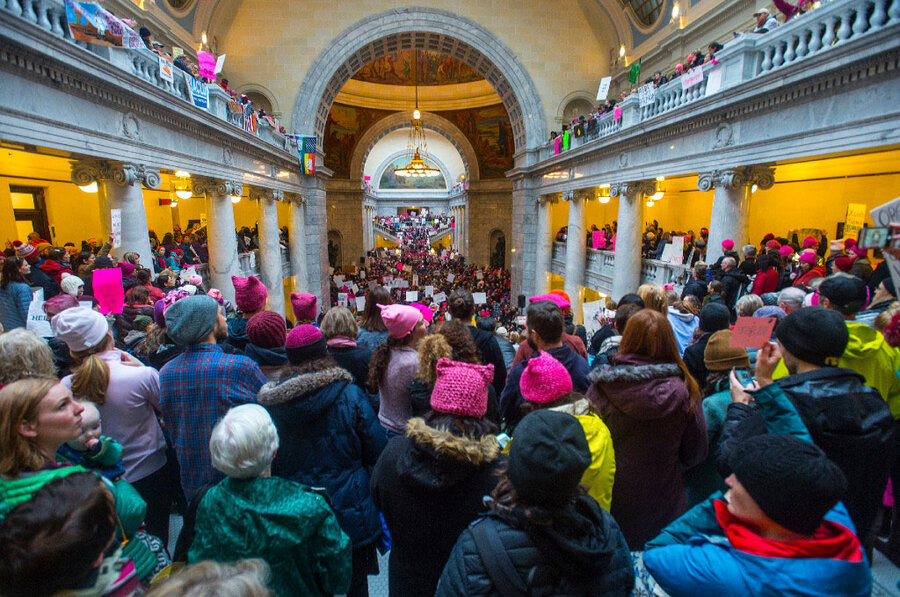In deep-red Utah, a GOP bill to study the wage gap
Watching speakers at the Salt Lake City Women’s March, Utah State Senator Jake Anderegg noticed that one frequent topic was equal pay.
Multiple studies have found that women earn less, on average, than their male counterparts for doing equivalent work. Senator Anderegg doesn’t deny that situation. But, having majored in economics, he was quick to question the data.
“The disparity of the wage gap was anywhere from 64 cents on the dollar all the way up to 92 cents on the dollar,” he tells The Christian Science Monitor in a phone interview. “And I started thinking, ‘Well, why the disparity?’”
To pin down these numbers, Mr. Anderegg has introduced a bill that would require Utah’s Department of Workforce Services to study that state’s wage gap. Utahns think this could be a first step towards closing that gap.
“I applaud him for what he's doing,” says Patricia Jones, a former Utah state senator and CEO of the Women’s Leadership Institute (WLI). “I think it needs to happen.”
While Utah has a general ban on employment discrimination, local media reports that it’s one of only six states without an equal pay law. Having worked to bring more women into corporate and political leadership roles, Mrs. Jones has seen evidence that “Utah does have a large wage gap.”
But no one seems to know exactly how large. One 2015 study, released by Voices for Utah’s Children and the University of Utah, found that the Beehive State’s women earn 70 cents for every dollar men earn. The Pew Charitable Trust says 76 cents on the dollar, while the US Bureau of Labor Statistics (BLS) puts it at 73.2 cents.
In Anderegg’s view, the problem was that the datasets generally used by these groups – the BLS’s Current Population Survey and Current Employment Statistics – rely on voluntary data collection.
But Utah’s Department of Workforce Services already collects statewide salary data for purposes of unemployment insurance. Anderegg realized that it would be a simple task to separate that information by gender. “Then we could actually go, category by category, through the labor statistics and say, ‘Ok, what is fair market value? What wage gap actually exists, and what is fair market value in the State of Utah?’ ”
“We're a pretty conservative state, and anecdotal information is not gonna compel my conservative colleagues” to act on pay disparity, he tells the Monitor. “But if we had real Utah numbers, and real Utah data,” lawmakers could then decide “what, if any, actions we take to address those issues.”
Anderegg, himself a Republican, acknowledges that he isn’t likely to back new regulations. But he thinks that the numbers themselves could empower women.
“I would bet [that], whatever wage gap exists, knowing before you go what fair market value is and going in and negotiating your contract based on what you could expect in the marketplace solves maybe 80, 90 percent of this issue.”
This could be true in many cases, says Victoria Budson, executive director of the Women and Public Policy Program at Harvard’s Kennedy School of Government, in a separate interview with the Monitor, though multiple studies have also noted that many women are penalized for aggressive negotiation tactics.
Ms. Budson points out that in Washington, D.C., where federal employees can easily see their pay scales, the wage gap is lower. “We find that the more transparency there is, the smaller the wage gap.”
She also notes that more and more employers are taking steps to shrink that gap. “The more effective businesses are in competing in the 21st century, the more they understand that closing the wage gap and managing their talent effectively is an important tool to doing so.”
Many corporations, she continues, have already undertaken internal audits and backed legislation in an effort to close that gap – measures that Utah’s employers may want to consider if the bill passes, and the study turns up evidence of a large gap.
But Budson also cautions that “any one of these interventions alone can't close the wage gap. The wage gap happens for a variety of reasons.”
In Utah, another one of those reasons may be the state’s deeply-entrenched Mormon culture, which Jones says has long encouraged women to stay at home.
Those attitudes have already sparked opposition to Anderegg’s bill. On February 15th, James Green, former vice-chair of the Wasatch County GOP, wrote an op-ed opposing the bill, warning that it could put downward pressure on men’s wages, and arguing that men “need to make enough to support their families and allow the Mother to remain in the home to raise and nurture the children.”
Senator Anderegg was quick to clarify that his bill doesn’t mandate equal pay, it just calls for a study to find out how unequal the state’s pay is.
“We're not willing to look at that?” he asks rhetorically. “It's kind of like we're burying our heads in the sand and pretending like the wage gap doesn't exist, or that we're not being sexist or discriminatory.”
As his bill works its way through the legislature, he’s drawn encouragement from the Utahns who have countered attitudes like those.
“I've gotten 30 or 40 emails from men, conservative men, criticizing me, saying ‘Hey, there is no wage gap.’ ” But he’s also received “about eighty-six emails from conservative women, who I work with throughout the state, who are all saying 'Thank you for looking into this.' "






